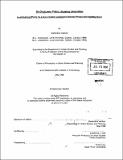| dc.contributor.advisor | Lawrence J. Vale. | en_US |
| dc.contributor.author | Vachon, Geneviève, 1966- | en_US |
| dc.date.accessioned | 2012-04-26T18:37:38Z | |
| dc.date.available | 2012-04-26T18:37:38Z | |
| dc.date.copyright | 1998 | en_US |
| dc.date.issued | 1998 | en_US |
| dc.identifier.uri | http://hdl.handle.net/1721.1/70311 | |
| dc.description | Thesis (Ph.D.)--Massachusetts Institute of Technology, Dept. of Urban Studies and Planning, 1998. | en_US |
| dc.description | Includes bibliographical references (v. 2, leaves 254-260). | en_US |
| dc.description.abstract | In 1992, the National Commission on Severely Distressed Public Housing (NCSDPH) clearly established the need to revitalize some of the most distressed and isolated housing environments in the U.S. In response, the Department of Housing and Urban Development (HUD) created HOPE VI, initially a demonstration program that evolved to support revitalization and integration models not only for the dilapidated projects, but also for the equally distressed surrounding neighborhoods. This dissertation seeks to illustrate the complexity of implementing integration efforts that seek to reverse public housing isolation by addressing two premises: 1) the integration of public housing constitutes a complex social, economic, cultural and physical matter that can, nonetheless, be clarified and coherently categorized with the help of a cross-national sample of fifteen HOPE VI revitalization efforts; and 2) public housing isolation is a multi-faceted issue that can best be understood through careful historical and morphological analysis of an individual public housing development, such as Boston's Mission Main. The dissertation is structured to highlight the mechanisms of an "isolation to integration" dynamic by analyzing, in its first part, pre-redevelopment isolation conditions and integration strategies for a fifteen-city sample (Chapters 2 and 3); and, in its second part, by detailing that dynamic for the Mission Main case (Chapters 4 and 5). More specifically, Chapter 1 traces the origins of an isolationist project mentality and its impact on design during sixty years of policymaking. Chapter 2 introduces pre redevelopment conditions as well as revitalization strategies for each of the sampled developments. Chapter 3 classifies integration strategies according to physical, socioeconomic and organizational variables. Finally, Chapter 4 investigates the roots of present day isolation in Mission Main, while Chapter 5 details the complex implementation process that characterized the Boston example. Results show that public housing isolation has origins outside the development, as revealed by morphological analysis of embedded external forces; and that re-designing the social and physical connection between project and neighborhood is a complex process influenced as much by pre-redevelopment conditions as by the desires of residents, designers or policymakers to foster integration. | en_US |
| dc.description.statementofresponsibility | by Geneviève Vachon. | en_US |
| dc.format.extent | 2 v. (261 leaves, [104] leaves of plates (some folded)) | en_US |
| dc.language.iso | eng | en_US |
| dc.publisher | Massachusetts Institute of Technology | en_US |
| dc.rights | M.I.T. theses are protected by
copyright. They may be viewed from this source for any purpose, but
reproduction or distribution in any format is prohibited without written
permission. See provided URL for inquiries about permission. | en_US |
| dc.rights.uri | http://dspace.mit.edu/handle/1721.1/7582 | en_US |
| dc.subject | Urban Studies and Planning | en_US |
| dc.title | Re-designing public housing integration : investigating efforts for a socio-spatial connection between project and neighborhood | en_US |
| dc.type | Thesis | en_US |
| dc.description.degree | Ph.D. | en_US |
| dc.contributor.department | Massachusetts Institute of Technology. Department of Urban Studies and Planning | |
| dc.identifier.oclc | 42464285 | en_US |

